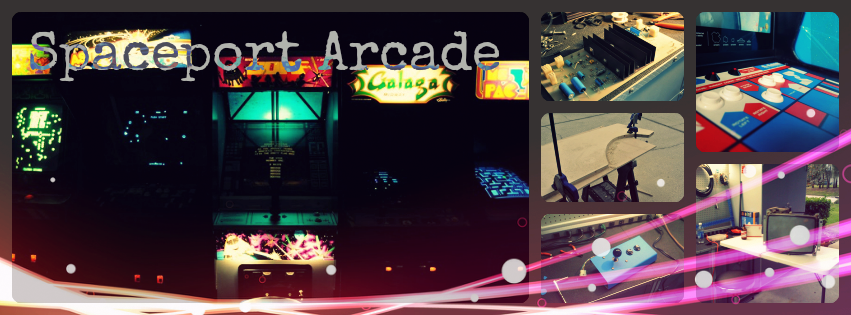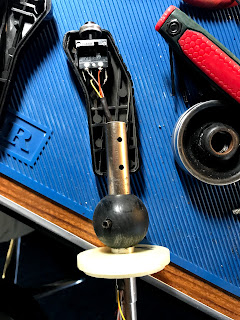A member of the villageBBS posted an Atari Battlezone as a non-working project, so I jumped at the chance to get it. The game was located in Ocala which is a few hours away from me. So since I had planned to drive up to visit my daughter in Jacksonville on Saturday, I made for the Battlezone early in the morning, then after pickup, continued on my trip north.
The cabinet was much like any other basket case project I've had over the years. It needed a new power cord, the back door was missing, the insides were caked with 30+ years of dust, and it showed very little sign of ever working again. On top of this, the two controllers were in disrepair, and needed to be cleaned and rebuilt.
I started off as usual just looking everything over. There were a number of things I needed to correct right away. I always start by replacing the power cord and on these Atari cabinets, I check out the power brick and make sure it's even the correct model for this game. I ordered a replacement "Big Blue" capacitor for the power brick and a cap kit for the AR2 voltage regulator. The operator had spliced into the power cord and added a light switch to the inside of the cabinet. I guess this would've been convenient at one time, so he could reach through the coin door and power off the machine. I removed that and crimped a new power cord down using the original three pin plug. I then replaced the capacitor, checked the fuses and tested the power brick voltages.
I then turned my attention to the AR2. The first thing I noticed was a little silver serial number sticker on the AR2. That got me thinking I hadn't seen one of those labels on earlier Atari vector games. In the past, I remember seeing them on my Space Duel and Gravitar. When I started investigating further, I realized I had the wrong version of AR2. This was a version 4 which I believe would've originally been from a Gravitar or Space Duel, but not Battlezone. Battlezone requires a version 2 AR2. Fortunately the AR2 boards are very similar and mine only needed a half dozen parts soldered in place in order to make it work like an AR2 version 2. There were a couple of large wire wound resistors that I needed to order so I got to work doing other things while waiting for the parts to arrive.
The cabinet was dusty and filthy so I got busy cleaning up what I could. I removed the monitor and saw that the colored overlays were stuck to the surface of the screen. The half silvered mirror was so dirty that I couldn't see through it. Once it was removed, I could then see the fluorescent cardboard insert was intact and in good shape. I used a soft brush and the vacuum cleaner to lift the dust off of the cardboard artwork. I cleaned the glass and wiped down the monitor. Battlezone used a black and white vector monitor, I believe mine is an Electrohome G05. They added a green and red color overlay to the screen to produce colors and those were reflected up onto the mirror which gave the effect of presenting the view upon the cardboard backdrop. The backdrop has some fluorescent paints, which are then lit up by a white black light mounted inside the front of the cabinet. Its a pretty awesome effect.
I did a little searching online and found that Bill at Biltronix had already sourced the needed replacements for the color overlay. He also pointed out that many of the Battlezones have the monitor mounted incorrectly, usually after having been removed for repairs. After looking closely I realized my monitor was indeed mounted incorrectly and that led to the original overlays being stuck to the screen rather than being supported above it. I ordered replacements, and decided I'd have to sort that out once the machine was working again.
Battlezone is unique in that it may be the first or one of the first virtual reality games. The front of the cabinet has a plastic shroud with a small window. You have to press your face against the periscope style bezel in order to see the display, and it's a nice immersive perspective. I removed the plastic bezel and cleaned it inside an out, each window had to be carefully removed and cleaned. During this time I also notice that one of the two speakers at the top of the cabinet were missing. The manual says its a 5 inch, 8 ohm speaker. I found a pair of replacements at parts-express.com. I decided to order the shielded speakers, as in the past I've encountered problems between the magnets in the speakers and the crt display. At this point I also replaced the black light and the fluorescent marquee light, and both starters.
From research I had done online, I knew that the internal parts of the controllers would need replaced. Fortunately there are aftermarket reproductions of the centering bellows. These you can order from Wizzesworkshop. I had actually been dreading what I would find when the time came to disassembling the controllers. Sure enough the old bellows were tore and needed replaced, but the rest of the bits were in pretty good shape. During the life of the game, someone had replaced the fire button, but since it's pretty much the same as the start buttons from other Atari games from that era, I happened to have one on hand. One item that was missing was the silver centering ring for the button. Also one of the controller handles was busted and had been held back together with long bolts that passed through both sides. I found a site that provides NOS parts (ArcadeFixIt.com) so I ordered the missing ring and both replacements for the broken halves of the right side controller. I dropped the plastic parts in a tub of Mr. Clean to soak for a few days.
When the parts arrived I got busy re-assembling the controllers with the new centering bezels. I also re-wired the fire button and fished the wires down through the handle. With the new button and centering ring the controller was looking great again. The two handle pieces were in excellent shape and I used the old allan head screws to hold it all together.
I removed the coin door and soaked the coin slots and return bezels in soapy water. These had been masked over with duct tape at some point and that needed removed. I also took this time to respray the worn surface of the coin doors with satin black Rustoleum. For the lower speaker grill, I masked off the surrounding cabinet and gave it a very light spray of the same satin black.
For the front step of this game, someone had done a nice job of installing green indoor outdoor carpet. This actually didn't look terrible, but I wanted something closer to original. I found some thin runner carpeting at Lowe's which they say by the foot. I purchased about 3 feet and it was more than enough to cover the step. It didn't look perfect but I think it is a nice improvement.
I cut a new backdoor and added a small vent similar to other Atari vector cabinets I've owned. I then added a new lock to the new back door and another with matching keys to the front coin door.
At this point as a final cosmetic touch, I decided to install new t-molding. I had found about 40 feet of it in the attic, which I must've ordered for a previous project and never gotten around to using it. So I replaced the t-molding, and with that I stood back and decided the cabinet was finally looking pretty good, or well enough.



















